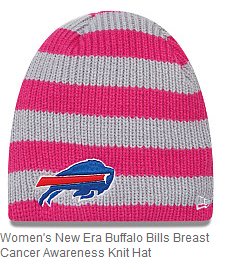NY Attorney General Calls On Breast Cancer Charities To Be Transparent About Where The Money Is Going Image courtesy of (NFL Shop)
Concerned that consumers are buying these pink items without sufficient information about how their purchases will benefit charity, AG Eric T. Schneiderman’s office undertook a year-long review of the so-called “pink ribbon” business and came up with five guidelines intended to protect consumers:
1. Clearly Describe the Promotion
Before you pay $20 for that pink knit hat, you should be able to easily discern the following: the name of the charity; the specific dollar amount per purchase that will go to charity; any caps on the donation; whether any consumer action is required to trigger a donation; and the start and end dates of the campaign.
2. Allow Consumers to Easily Determine Donation Amount
Enough with the “portion of the proceeds” crap, says the AG. The charities and the companies they align with should just state the actual amount.
3. Be Transparent About What Is Not Apparent
Sometimes there are limits to how much of a company’s proceeds will be donated, or if the donation is not going to given in cash to the charity. This sort of information should be made readily available to the consumer.
4. Ensure Transparency in Social Media
The level of transparency shouldn’t be limited by the fact that you can only Tweet 140 characters at a time. Charities and companies need to be equally transparent in their marketing across all platforms.
5. Tell the Public How Much Was Raised
When a fundraising campaign is over, the charity’s site should clearly post how much was earned. We assume the AG means actual donation to the charity and not gross revenue from the sale of merchandise.
The Susan G. Komen For the Cure foundation, which has garnered a lot of criticism for its eagerness to splash pink over any product it can think of, has agreed to sign on to the best practices, as has the Breast Cancer Research Foundation.
Of course, these best practices are not legally binding, so we’ll just have to keep an eye on things to see if companies follow through with the promise.
Want more consumer news? Visit our parent organization, Consumer Reports, for the latest on scams, recalls, and other consumer issues.



